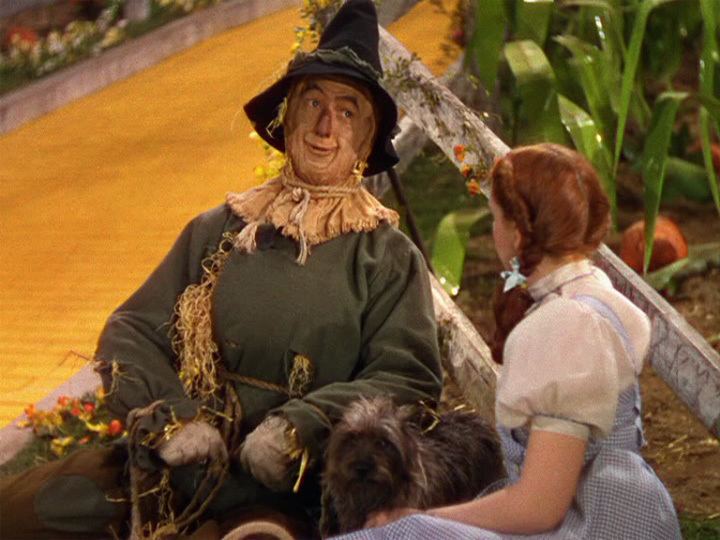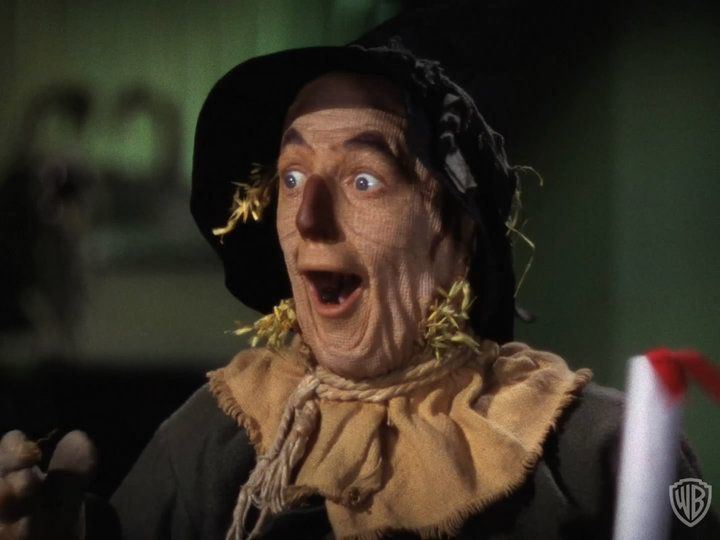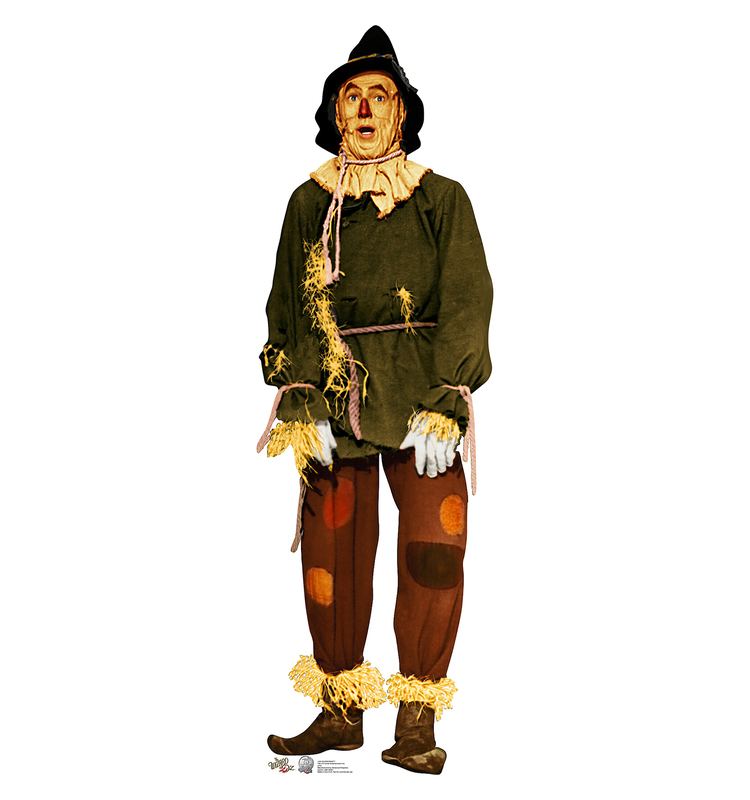Created by L. Frank Baum Creator L. Frank Baum Significant other Sarima | Gender Male | |
 | ||
Aliases Socrates StrawmanChang Wang WoeFiyero Tigelaar Played by Similar | ||
The Scarecrow is a character in the fictional Land of Oz created by American author L. Frank Baum and illustrator W.W. Denslow. In his first appearance, the Scarecrow reveals that he lacks a brain and desires above all else to have one. In reality, he is only two days old and merely ignorant. Throughout the course of the novel, he demonstrates that he already has the brains he seeks and is later recognized as "the wisest man in all of Oz," although he continues to credit the Wizard for them. He is, however, wise enough to know his own limitations and all too happy to hand the rulership of Oz, passed to him by the Wizard, to Princess Ozma, to become one of her trusted advisors, though he typically spends more time playing games than advising.
Contents
- In The Wonderful Wizard of Oz
- In Wicked Musical
- In the Novel Wicked by Gregory Maguire
- In the Novel Son of a Witch by Gregory Maguire
- Scholarly interpretations
- Later Oz books
- Early films
- The Wizard of Oz
- The Oz Kids
- Oz the Great and Powerful
- Other adaptations
- Modern works
- References

In The Wonderful Wizard of Oz

In Baum's classic 1900 novel The Wonderful Wizard of Oz, the living scarecrow encounters Dorothy Gale in a field in the Munchkin Country while she is on her way to the Emerald City. He tells her about his creation and of how he at first scared away the crows, before an older one realised he was a straw man, causing the other crows to start eating the corn. The old crow then told the Scarecrow of the importance of brains. The "mindless" Scarecrow joins Dorothy in the hope that The Wizard will give him a brain. They are later joined by the Tin Woodman and the Cowardly Lion. When the group goes to the West, he kills the Witch's crows by twisting their necks. He is taken apart by the Flying Monkeys and his clothes thrown up a tree, but when his clothes are filled with straw he is back again. After Dorothy and her friends have completed their mission to kill the Wicked Witch of the West, the Wizard gives the Scarecrow brains (made out of bran, pins and needles – in reality a placebo, as he has been the most intelligent of the travelers all along). Before he leaves Oz in a balloon, the Wizard appoints the Scarecrow to rule the Emerald City in his stead. He accompanies Dorothy and the others to the palace of the Good Witch of the South Glinda, and she uses the Golden Cap to summon the Winged Monkeys, who take the Scarecrow back to the Emerald City.

His desire for a brain notably contrasts with the Tin Woodman's desire for a heart, reflecting a common debate between the relative importance of the mind and the emotions. Indeed, both believe they have neither. This occasions philosophical debate between the two friends as to why their own choices are superior; neither convinces the other, and Dorothy, listening, is unable to decide which one is right. Symbolically, because they remain with Dorothy throughout her quest, she is provided with both and need not select.
In Wicked Musical

In the musical of Gregory Maguire's interpretation of the Oz franchise, this version of the Scarecrow was Fiyero Tigelaar, the love interest of Elphaba Thropp. Fiyero attends school with Elphaba and Glinda the Good, while they were all still young. Fiyero takes a special interest in Elphaba. However, he is highly sought after by Elphaba's roommate, Glinda. Fiyero and Elphaba share a secret romance, and when she leaves for the Emerald City, he gives her a long and meaningful goodbye.

Many years later, after Elphaba goes into hiding, we are shown that Glinda and Fiyero are to be wed. However this is not because of love, at least not on Fiyero's part, for he still loves Elphaba. Once she reappears in the Emerald City, they escape together, much to Glinda's discontent. Elphaba then goes to the site of her sister's death (Dorothy's arrival into Oz). Here she is ambushed by guards, and about to be taken away, when Fiyero saves her, but he is merely sacrificing himself to save her. Elphaba in a fit of rage and heartbreak reads a spell to keep Fiyero safe, with the words of the spell including pleas to let him feel no pain and never die however they try to destroy him. Although Elphaba abandons the spell as she believes it is not working, it is not until the end of the production that we are shown that Fiyero is still alive, and has been transformed into the Scarecrow from "The Wonderful Wizard of Oz".
In the Novel "Wicked" by Gregory Maguire
In Gregory Maguire's novel "Wicked: The Life and Times of the Wicked Witch of the West" The Scarecrow is a companion of Dorothy. When the quartet of Dorothy, The Scarecrow, Tin Woodman, and Lion approach Elphaba's home in Fiyero's castle, she thinks for a moment that maybe Fiyero is the Scarecrow, having not died earlier in the novel. She sends minions after him to tear him apart to see if Fiyero is inside, but he is not. In the novel he is NOT Fiyero, but this is probably where they got the idea for the stage version.
In the Novel "Son of a Witch" by Gregory Maguire
The Scarecrow appears briefly in this novel, first giving Liir advice. When he appears at Glinda's induction Liir notes that it is an obvious impostor and not the same Scarecrow that he once knew.
Scholarly interpretations
Economics and history professors have published scholarly studies that indicate the images and characters used by Baum and Denslow closely resembled political images that were well known in the 1890s. The Scarecrow, like other characters and elements in The Wonderful Wizard of Oz, was a common theme found in editorial cartoons of the previous decade. Baum and Denslow, like most writers, used the materials at hand that they knew best. They built a story around them, added Dorothy, and added a series of lessons to the effect that everyone possesses the resources they need (such as brains, a heart and courage) if only they had self-confidence. Although it was a children’s book, of course, Baum noted in the preface that it was a "modernized" fairy tale as well.
Those who interpret The Wonderful Wizard of Oz as a political allegory often see the Scarecrow, a central figure, as a reflection of the popular image of the American farmer—although he has been persuaded that he is only a dumb hick, he possesses a strong common sense, remarkable insight and quick-wittedness that needs only to be reinforced by self-confidence.
The blackface minstrel star, Fred Stone, was the first to play the Scarecrow on stage, and he brought his minstrel style of performance to the role of the Scarecrow. Baum was delighted with Stone's performance, and he wrote subsequent Oz books with Stone's minstrel-style in mind.
Later Oz books
The Scarecrow also appears in other Oz books, sharing further adventures with Dorothy and her friends. His reign as king of the Emerald City ends in The Marvelous Land of Oz when General Jinjur and her Army of Revolt oust him in a coup. He manages to escape the palace and joins Tip and his companions in seeking the aid of Glinda the Good.
He spars with H. M. Woggle-Bug T. E. on the value of education. Although he claims to be educated himself and to value education, he finds the Woggle-Bug's learning rote and without wisdom. Although he cannot eat, he tells Billina that she might be better cooked and generally seems to favor the use of animals as food, sometimes making snide remarks to that effect to his animal companions, although he himself only gathers nuts and fruit for his traveling companions, such as Dorothy and Tip, to eat.
By The Road to Oz he is acknowledged, at least by the Tin Woodman, to be "probably the wisest man in all Oz," and this is the caption of an illustration, suggesting that the reader take his comment at face value. Dorothy herself, in Dorothy and the Wizard in Oz praises the Scarecrow's wisdom and says the Scarecrow seemed just as wise before the Wizard gave him brains as after.
In The Emerald City of Oz, the Scarecrow lives in a house shaped like an ear of corn in Winkie Country. In The Scarecrow of Oz, the Scarecrow travels to Jinxland, where he helps Cap'n Bill, Trot and Button-Bright overthrow the villainous King Krewl.
In Glinda of Oz the Scarecrow serves as Regent to Ozma of Oz, demonstrating that he is Ozma's third in command. Mostly all he does is play croquet until Ozma's advisers, including himself, band together for a rescue operation.
In The Royal Book of Oz by Ruth Plumly Thompson, Baum's authorized successor as "Royal Historian of Oz", Professor Woggle-Bug accused the Scarecrow of having no ancestry, so he returns to the pole at the cornfield where he was once hung. Sliding down it and descending underground, he first encounters the Midlings and then the Silver Islands, whose people believe themselves to be the ancestors of the Chinese. Apparently, when Emperor Chang Wang Woe defeated the king of the Golden Islands in battle, the king hired a sorcerer to sneak into the palace and transform the Emperor into a crocus, which later sprouted into a bean pole, preceding a prophecy that the first being to touch the bean pole would become possessed by the spirit of the Emperor. As it turned out, the first thing to touch the pole was the straw-stuffed human, which would become the Scarecrow. This account is not consistent with the Scarecrow's story in The Wonderful Wizard of Oz of becoming aware of each sense as the relevant organs were painted on his head.
Early films
The Scarecrow has appeared in nearly every early Oz film, portrayed by different actors each time.
The Wizard of Oz
In the 1939 film The Wizard of Oz, the Scarecrow was played by Ray Bolger in what is arguably the actor's most famous role. He was originally cast as the Tin Woodsman, but Bolger had always wanted to play the Scarecrow, so he was upset about it since he wanted to switch roles with Buddy Ebsen, who was originally going to play the Scarecrow. Ebsen didn't mind the swap, so Bolger and Ebsen swapped roles. While Ray was pleased with his role as the Scarecrow, the aluminum dust from Ebsen's Tin Man make-up nearly choked him to the edge of death (causing Ebsen to have to give up that role). Ebsen was replaced by Jack Haley for his role of the Tin Man. Bolger's costume consisted of a straw-stuffed suit and a light face mask of rubber designed to simulate burlap. The mask was fragile, and usually had to be completely replaced at the start of each new day of filming. Bolger's Scarecrow costume, minus the mask, is part of the collections of the National Museum of American History at the Smithsonian Institution. Bolger was a talented dancer, so The Scarecrow was given an extended dance sequence in the movie. However, to shorten the movie, much of this sequence was edited out since it would slow down the film. While Bolger admitted in a 1939 radio broadcast that he was too young to have seen Fred Stone play the Scarecrow in the 1902 musical extravaganza, he told Stone on the broadcast that the first play he was allowed to see was The Red Mill featuring Stone, and that his performance in that play was an inspiration.
During the scene where the Wizard gives him his brains, the Scarecrow makes a mistake in his first educated pronouncement. He recites the Pythagorean theorem stating that it applies to an isosceles triangle, which is incorrect, as it applies to a right triangle; he also refers to square roots, not to squares. This probably reflects ignorance by the scriptwriters, not the Scarecrow.
Bolger also portrayed the Scarecrow's Kansas counterpart, Hunk (one of Aunt Em and Uncle Henry's farmworkers), newly created for the film by screenwriter Noel Langley. A scene which was written in the script, but dropped before filming commenced, ended the movie by sending Hunk off to agricultural college, with Dorothy promising to write. The scene implied the potential for a romance between the two characters.
He helps Zeke (Cowardly Lion's alter ego) and Hickory (Tin Man's alter ego) repair a wagon. Unlike Zeke, Hickory and Hunk lose their hats with Uncle Henry as they struggle to open the cellar when the tornado approaches their farm. He closes and locks the cellar with Zeke when Dorothy arrives at the farmhouse. Hunk reunites with Dorothy when she awakens from being unconscious. He is seen with Aunt Em, Uncle Henry, Zeke, Hickory, and Professor Marvel (The Wizard's alter ego).
The Oz Kids
In 1996, they made a cartoon animated The Oz Kids. He has a son named Scarecrow, Jr. His son is smart and knows everything just like him. Scarecrow, Sr. is voiced by Andy Milder.
Oz the Great and Powerful
In the 2013 film Oz the Great and Powerful, the Scarecrow's origins are explained; being fabricated by the townspeople of Oz as a diversionary tactic during the retaliatory attack on the Emerald City.
Other adaptations
In the 1925 film, Wizard of Oz, the Scarecrow and the Tin Man were actually human farmhands, who were blown to Oz by the tornado along with Dorothy. They don disguises and help overthrow a usurper. Dorothy, in another major departure from the novel, turns out to be the rightful ruler of Oz, having been exiled to Kansas as a baby. None other than Oliver Hardy played the Tin Man.
Hinton Battle originated the role of the Scarecrow in the 1975 Broadway musical The Wiz, and Michael Jackson played the Scarecrow in the 1978 film adaptation. This version of the Scarecrow was a more tragic character before Dorothy rescues him; while hung on his pole, the crows he is unable to scare, who force him to humiliate himself and entertain them, torment him day and night. They force him to sing the song, "You Can't Win", meaning that he cannot escape the crows' rule and his bad luck. While Stan Winston created Jackson's makeup, it was applied to Jackson's face by Michael R. Thomas who portrayed the Scarecrow in Barry Mahon's The Wonderful Land of Oz (1969), as well as doing the makeup for that film. Elijah Kelley portrayed the Scarecrow in the TV special The Wiz Live!, as well as the farmhand Sticks.
In the animated film Journey Back to Oz (produced in 1964 but not released until the 1970s), the Scarecrow was voiced by Mickey Rooney.
In an episode of The World's Greatest Super Friends, Aquaman temporarily became the Scarecrow after a tornado took him, Superman and Wonder Woman to Mister Mxyzptlk’s planet of Oz.
In a 1981 episode of Scooby-Doo and Scrappy-Doo, Shaggy is dressed as the Scarecrow after a tornado took him, Scooby, and Scrappy to "Ahz", a direct spoof of Oz with a different spelling by its enunciation.
Justin Case, an English bicycle acrobat, appeared briefly as the Scarecrow in the 1985 film Return to Oz.
American voice actor Michael Gough voices the Scarecrow in 2011's direct-to-DVD animated film Tom and Jerry and the Wizard of Oz.
The Scarecrow appeared in Legends of Oz: Dorothy's Return (which is based on Dorothy of Oz) voiced by Dan Aykroyd.
